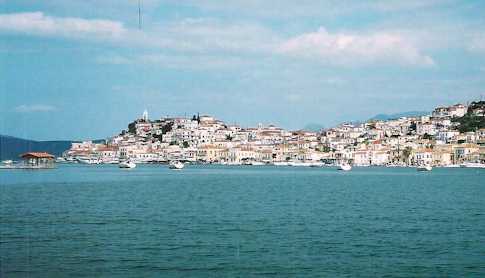
Greenwood's old friend, Ron living in Manhattan Beach, US visited Aegean sea with his family in April 2002. He kindly shared some of his photos with comments as exhibited here: Mr. Greenwood visited Athens in 30 years ago, but he never visited Aegean sea.
We had a great trip to Greece. It was organized by the Univ. of Minnesota
Alumni. As you could guess they kept us pretty busy. They had very informed lectures in
the hotel most days, talking about everything from ancient legends to modern Greece.
The first lecture was 8:30 AM the day after we arrived! (We didn't even wake up until 8
AM, so gave that one a miss). Many of our other travelers were late, which isn't
surprising. Before leaving on the trip, they sent us small notebooks and we wondered why.
When we saw some of the more committed travelers taking copious notes, we understood. And
we thought we were going for a vacation!
After that rather busy start, things slowed down to a sustainable pace. The lectures were
very good and helped us understand what we were going to see. The biggest impression we
had is the sheer beauty of the islands (Athens seems to be just another modern w. European
city - more torn up than most, because of preparations for the Olympics). The Aegean sea
is very clear - similar to that on the Barrier Reef! Apparently there is an upwelling
circulation which keeps it very clean. Not too good for fishing we were told, probably no
nutrients in the clear water.
As you know we stayed on Poros which is 50 miles and about an hour by hydrofoil from
Athens. Later in the year it gets very crowded by Greeks on their weekends off, but was
comfortable when we were there. Poros is still rather unspoiled, but discreet developments
of big houses are beginning to appear near the town. I expect it'll soon get very built up
with weekend "villas". I have no idea if the figures are accurate, but one Greek
said a small house in Poros goes for only 10,000 Euros, a "big" one for 30,000.
Some mansions (probably bigger than his "big") we saw must be more than 600 sq.
m. Incidentally, almost all the new houses, and many of the old ones, had both solar water
heaters and heat pump heating/cooling units. The climate and cost of energy may be close
to Tokyo's and most houses had only the one heat pump - probably in the bedroom, like
yours.

Poros
The town on a small peninsula, with the mainland (Peloponnese) in the background.
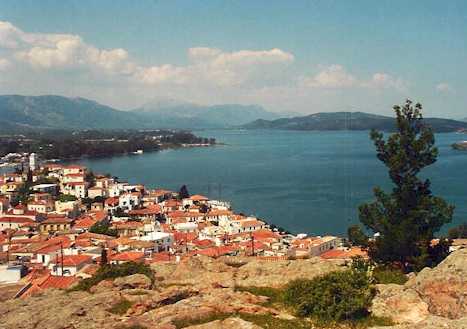
Poros and Peloponnese Peninsula
Quite beautiful. Peloponnese to left across a narrow straight.
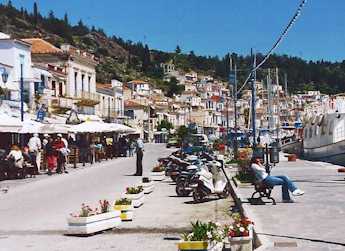
Waterfront of Poros
The center of the action in town. Note the row of waterfront cafes on the left. It's hard to see, but they're less than half full (April). Later - watch out for crowds!
Each day we went to one or other island or historical sights. I didn't realize before, but there are many "Acropolis' " (Acropoles?) in Greece. It simply means "city on the hill" and there are many of them. One of the most impressive was in Mycenae - dating back almost 3500 years. Traveling over the roads in the Peloponnese you can easily understand why the Greeks used stones to build their walls - the ground is covered with stones and boulders of all sizes, even today.

Hydra
What used to be a very wealthy island, now visited by very wealthy people. There are no wheeled vehicles on Hydra - Donkeys do ALL the hauling. We saw them carrying everything from roof tiles to air conditioners. The gray yacht roared out of the harbor a little later.
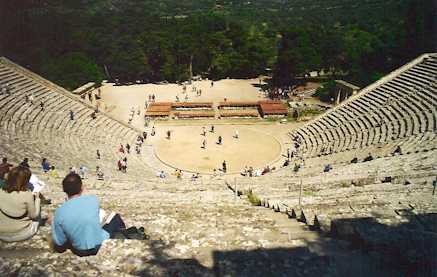
amphitheater of Epidaurus
An incredibly well preserved amphitheater. Seats 15,000 people, is still in use and you really can hear someone speaking in the center from the top of the stands where I took this picture. Our guide is the small black figure in the center of the circle. She was reading a poem. (Note 28 mm lens was too narrow for the span of the auditorium).
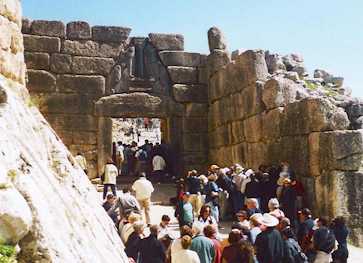
Lions' Gate of Mycenae
Home of Agamemnon (about 1250 BC) of the Trojan War. A massive citadel on a high bluff overlooking one of the richest plains in Greece. The walls were originally twice as high. Later Greeks believed only the Cyclops could have raised these massive stones. Even though it's only April (22nd), the crowds are beginning to thicken - I can't imagine going there in the summer.
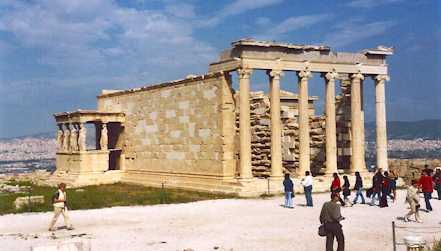
Erechthion of Acropolis hill
Adjacent to the Parthenon on the Acropolis hill. This has already been restored (note the whiter stones). For the Olympic Games they are rebuilding all the major structures on the Acropolis, including the Parthenon, below. Some of the damage is due to war and pillage, other by Athens' notorious acid smog (nefos). There are those who thank Lord Elgin for taking most of the best statuary to London, where they have been better preserved. All the outdoor statues (e.g. the Caryatids on the left) are now copies. The originals have been moved inside to stop further erosion/corrosion.
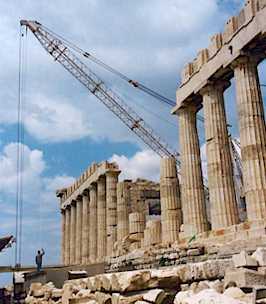
Parthenon and Crane
I guess you've seen plenty of pictures of the Parthenon. Guess what? There's less there now. It's been partially dismantled - note the piles of (numbered) stones in the foreground. They are busy making replacement parts and rebuilding the whole thing.
(Construction Engineer's comment: On all the Greek sites we visited, the only items of protective clothing we saw were sunglasses - not even one hard hat! - Even where masons were chipping away marble blocks with power tools high overhead on scaffolding. I wonder how many will lose eyesight and limbs, perhaps life before the Olympics start in 2004.)
I'd also been under the impression that the arch and the dome were Roman
inventions. However in a couple of tombs from before 1000 BC
there were what I believe to be arches and domes. It'd be interesting to get a
professional opinion.
All-in-all, a wonderful holiday. As a time of year to visit I definitely recommend April.
Crowds are still sparse and the temperatures were ideal (highs 18 - 20 C). Apparently it
can reach over 40 C in the summer, even on the islands (humid, too, I expect, being in the
sea). Fall is also supposed to be good.
25/06/02